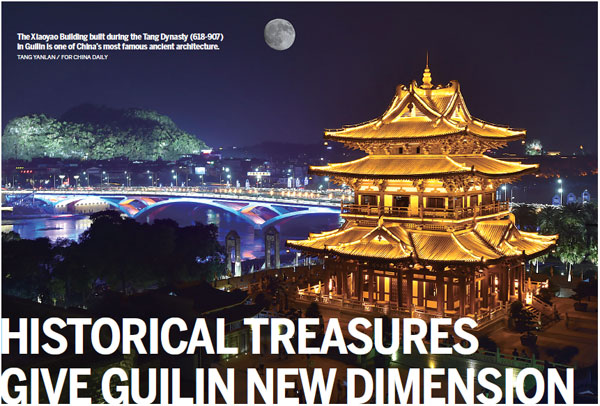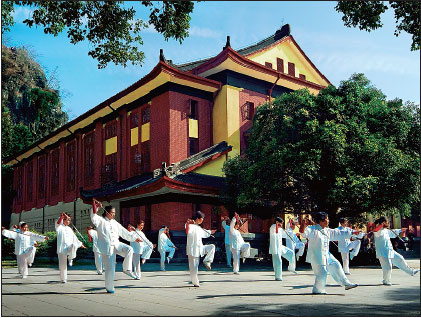Historical Treasures Give Guilin New Dimension
Rich cultural legacy set to attract more tourists to hot spot, Li Yang reports.
Guilin, a popular tourist city in the Guangxi Zhuang autonomous region, has been renowned for its picturesque karst landscape for centuries.
Now the city is looking to exploit its historical cultural resources to add a new dimension of human interests to its charm.
"Guilin's natural scenery is world-renowned. But few people know about its historical culture," said Zhao Leqin, Party chief of Guilin. "As citizens of Guilin, we are responsible for safeguarding its cultural power and ensuring that such power is put to good use."

The city government dismantled a large slum town recently in the center of Guilin around Jingjiang Prince Palace in order to uncover historical buildings and lanes that had been submerged by the slums. Some of the hidden structures are actually older than the palace.
The palace is actually a rectangular courtyard, which is encircled by solid stone walls and covers an area of 150,000 square meters.
It was built between 1372 and 1392 by Jingjiang King Zhu Shouqian, the great-nephew of Zhu Yuanzhang, the founder of the Ming Dynasty (1368-1644). It was home to 14 princes of the Ming Dynasty's Zhu family.
During the Qing Dynasty (1644-1911), family homes and communities sprang up around the palace walls.
The renovation project injected new life into both the Xiaoyao Building and Dongxi Lane, which were both built during the Tang Dynasty (618-907) and were gradually consumed by the slum town that began to spread in the early 20th century.
Dongxi Lane, or East-West Lane, is the oldest road in Guilin, and it has borne witness to the city's ups and downs over the past 1,400 years.
Working from historical records, the local government rebuilt the Xiaoyao Building on its original site near the Lijiang River. It is a 23.6-meter high, two-story wood-and-tile building, built on an above-ground 1.5-meter-high stone foundation.
Zhou Jiabin, mayor of Guilin, said the historical sites and relics can help to enhance Guilin's core competitiveness and foster the development of its cultural industry. The government has also renovated five old residences of famous people and Yanshan Park, and opened Zengpiyan Hill State Archaeology Relic Park and the Flying Tigers Relic Park.
The latter was built to commemorate the pilots from the United States Army Air Corps, Navy, and Marine Corps, nicknamed "The Flying Tigers", who, under the authority of the US president, were tasked with defending China against Japanese forces.
"We must focus on the protection of our historical heritage," Zhou said.
The construction of Guilin Wanda Cultural Tourism City is the latest example of the city's drive to attract more tourists. Work on the project began in May, with a total investment of 30 billion yuan ($4.62 billion).
It is anticipated that the project will be completed by 2020 and receive 20 million visitors annually. The local government regards the project as an important step toward its objective of building a global tourism resort, which is also in line with the ambition of the central government.
Statistics show that a total of 44.7 million tourist trips were made to Guilin last year, a significant increase on the figure of 20 million that was recorded in 2011.
The city's annual tourism revenue increased from 21.54 billion yuan in 2011 to 51.73 billion yuan last year. The average expenditure of each tourist in Guilin was 1,157 yuan last year, nearly twice as much as in 2010.
The local government has also encouraged farmers in the villages surrounding Guilin to turn their homes into family inns and restaurants so that tourists can get a genuine flavor of local life, so farmers can reap the financial rewards of increased tourism.
Guilin has offered a 72-hour visa-free transit stay for travelers from 51 countries since July 2014, and a six-day visa-free stay for travelers from the 10 counties of the Association of Southeast Asian Nations. In the first half of this year, 24.46 million tourism trips were made to Guilin, up 30.04 percent year-on-year. Of these trips, 1.08 million were from the Chinese mainland, up 4.56 percent compared with the same period last year. In addition, Guilin's tourism revenue in the first half of this year was 27.14 billion yuan, an increase of 31.35 percent, year-on-year.
Contact the writer at liyang@chinadaily.com.cn
|
The Xiaoyao Building built during the Tang Dynasty (618-907) in Guilin is one of China's most famous ancient architecture. |
|
Residents perform tai chi at Jingjiang Prince Palace in Guilin.Provided To China Daily |
(China Daily 10/18/2016 page12)




















